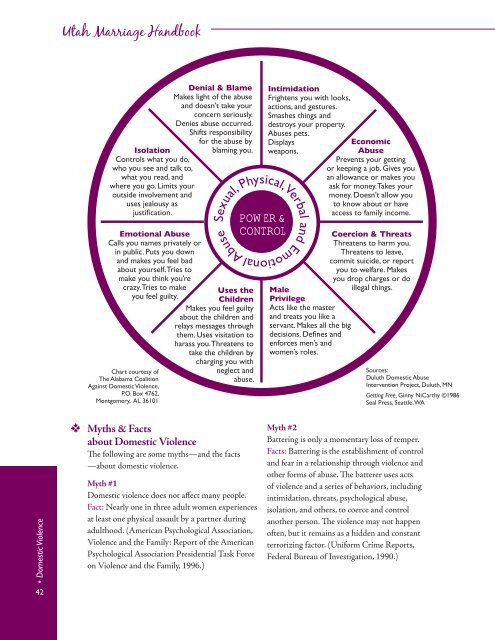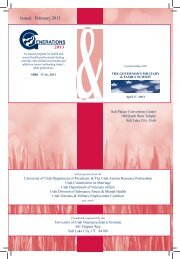The Utah Marriage Handbook - Stronger Marriage
The Utah Marriage Handbook - Stronger Marriage
The Utah Marriage Handbook - Stronger Marriage
You also want an ePaper? Increase the reach of your titles
YUMPU automatically turns print PDFs into web optimized ePapers that Google loves.
• Domestic Violence<br />
42<br />
<strong>Utah</strong> <strong>Marriage</strong> <strong>Handbook</strong><br />
Isolation<br />
Controls what you do,<br />
who you see and talk to,<br />
what you read, and<br />
where you go. Limits your<br />
outside involvement and<br />
uses jealousy as<br />
justification.<br />
Emotional Abuse<br />
Calls you names privately or<br />
in public. Puts you down<br />
and makes you feel bad<br />
about yourself. Tries to<br />
make you think you’re<br />
crazy. Tries to make<br />
you feel guilty.<br />
Chart courtesy of<br />
<strong>The</strong> Alabama Coalition<br />
Against Domestic Violence,<br />
P.O. Box 4762,<br />
Montgomery, AL 36101<br />
Denial & Blame<br />
Makes light of the abuse<br />
and doesn’t take your<br />
concern seriously.<br />
Denies abuse occurred.<br />
Shifts responsibility<br />
for the abuse by<br />
blaming you.<br />
Uses the<br />
Children<br />
Makes you feel guilty<br />
about the children and<br />
relays messages through<br />
them. Uses visitation to<br />
harass you. Threatens to<br />
take the children by<br />
charging you with<br />
neglect and<br />
abuse.<br />
Myths & Facts<br />
about Domestic Violence<br />
<strong>The</strong> following are some myths—and the facts<br />
—about domestic violence.<br />
Myth #1<br />
Domestic violence does not affect many people.<br />
Fact: Nearly one in three adult women experiences<br />
at least one physical assault by a partner during<br />
adulthood. (American Psychological Association,<br />
Violence and the Family: Report of the American<br />
Psychological Association Presidential Task Force<br />
on Violence and the Family, 1996.)<br />
Sexual, Physical, Verbal and Emotional Abuse<br />
POWER &<br />
CONTROL<br />
Intimidation<br />
Frightens you with looks,<br />
actions, and gestures.<br />
Smashes things and<br />
destroys your property.<br />
Abuses pets.<br />
Displays<br />
weapons.<br />
Male<br />
Privilege<br />
Acts like the master<br />
and treats you like a<br />
servant. Makes all the big<br />
decisions. Defines and<br />
enforces men’s and<br />
women’s roles.<br />
Economic<br />
Abuse<br />
Prevents your getting<br />
or keeping a job. Gives you<br />
an allowance or makes you<br />
ask for money. Takes your<br />
money. Doesn’t allow you<br />
to know about or have<br />
access to family income.<br />
Coercion & Threats<br />
Threatens to harm you.<br />
Threatens to leave,<br />
commit suicide, or report<br />
you to welfare. Makes<br />
you drop charges or do<br />
illegal things.<br />
Sources:<br />
Duluth Domestic Abuse<br />
Intervention Project, Duluth, MN<br />
Getting Free, Ginny NiCarthy ©1986<br />
Seal Press, Seattle, WA<br />
Myth #2<br />
Battering is only a momentary loss of temper.<br />
Facts: Battering is the establishment of control<br />
and fear in a relationship through violence and<br />
other forms of abuse. <strong>The</strong> batterer uses acts<br />
of violence and a series of behaviors, including<br />
intimidation, threats, psychological abuse,<br />
isolation, and others, to coerce and control<br />
another person. <strong>The</strong> violence may not happen<br />
often, but it remains as a hidden and constant<br />
terrorizing factor. (Uniform Crime Reports,<br />
Federal Bureau of Investigation, 1990.)




